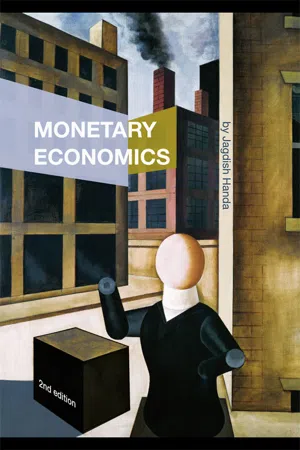Economics
Bank of Canada
The Bank of Canada is the country's central bank, responsible for monetary policy, issuing currency, and promoting a stable and efficient financial system. It conducts monetary policy to control inflation and promote economic stability, and it also acts as the government's fiscal agent, managing public debt and foreign exchange reserves.
Written by Perlego with AI-assistance
Related key terms
5 Key excerpts on "Bank of Canada"
- Anne Dolganos Picker(Author)
- 2011(Publication Date)
- Wiley(Publisher)
In March 1935, the Bank was open for business as a privately owned institution, with shares sold to the public. But this did not last long. A new government nationalized the Bank, and in 1938 it became publicly owned and remains that way today. The Bank of Canada Act, which defines the Bank’s functions, has been amended many times but the preamble has not changed. The Bank still exists “to regulate credit and currency in the best interests of the economic life of the nation.”The Bank’s organization integrated new functions with those that already existed elsewhere. When the Bank opened, it became the sole issuer of Canadian currency after banknote operations were transferred from the Department of Finance. Among the many new features of the Bank was a Research Division, which was established to provide information and advice on financial developments and on general business conditions at home and abroad. The Foreign Exchange Division and the Securities Division became operative almost immediately, though the transfer of the Public Debt Division from the Department of Finance was delayed until suitable quarters were available. This did not occur until 1938, following completion of the present Bank of Canada building in Ottawa. The Bank also has regional offices in Vancouver, Calgary, Toronto, Montréal, and Halifax in Canada and, like the Bank of Japan and the Reserve Bank of Australia, a New York City office.The Bank is structured like many corporate entities. Overall responsibility for business affairs rests with its Board of Directors, and the Governor of the Bank is the Chief Executive Officer and Chairman of the Board. Collective responsibility for management of the Bank is in the hands of its Governing Council.MONETARY POLICYThe Bank carries out monetary policy by influencing short-term interest rates by setting the overnight target. This in turn affects monetary conditions—that is, the impact of short-term interest rates and the Canadian dollar’s exchange rate on the economy. The transmission of monetary policy occurs as changes in monetary conditions affect the demand for goods and services. Lower interest rates, for example, tend to increase spending and reduce savings, and a lower dollar can boost exports and hold back imports. Conversely, higher interest rates tend to curb domestic spending and a higher dollar tends to curb exports and encourage imports. Strong demand for Canadian goods and services puts upward pressure on prices if it exceeds the economy’s capacity. Changes in monetary conditions affect inflation only indirectly and are usually felt over a period of 18 months to two years.- eBook - ePub
Bennett
The Rebel Who Challenged and Changed a Nation
- John Boyko(Author)
- 2012(Publication Date)
- Goose Lane Editions(Publisher)
While the government is in charge of fiscal policy, through which it influences the economy by manipulating taxing and spending, the Bank of Canada exerts its influence through controlling monetary policy. Broadly put, monetary policy involves managing the number of dollars in the economy by manipulating the ease with which credit is available. It performs that trick through raising or lowering the interest rate that it demands from the chartered banks that borrow money from its coffers and thereby influences the rates that banks charge their customers. Through these actions, the bank tries to control inflation and keep the economy stable. It influences the value of the dollar and renders international business transactions predictable and reliable. It also controls the look and production of money. The bank operates independently from Parliament so that it is free from the temptation of politicians who might wish to manoeuvre monetary policy for short-term political gain. Former American Federal Reserve chair Alan Greenspan has quipped that a central bank’s job is to see when the party is slowing down and take in a spiked punch bowl and, conversely, when the party looks like it may get out of hand, to go back in and remove it. 38 Teetotalling Bennett needed to offer spiked punch to Canadian bankers. Bennett was unable to concoct the brew, however, because at that time the Canadian government controlled only fiscal and trade policies. He needed the power to control monetary policy. Bennett’s business and legal background, coupled with his experience on the board of the Royal Bank, allowed him to understand well how banks worked. He personally knew many of those who ran them. In the early spring of 1932 Bennett wrote to several of his friends and contacts in the banking industry about the notion of a central bank. Among the responses he received was a well-researched and thoughtful essay from Randolph Nobel - eBook - ePub
- Jagdish Handa(Author)
- 2002(Publication Date)
- Routledge(Publisher)
The central bank, in setting or changing its discount rate, indicates its willingness to let the commercial banks determine the extent of the borrowing from it and thereby change the monetary base in the economy. Any announced change in this rate acts as an indicator of the Bank’s future intentions about the interest rates that it will support through its open market operations and therefore serves as an indicator of the future stance of monetary policy. The commercial banks and other financial intermediaries usually, though not always, follow the lead given by the discount rate changes to alter their own interest rates – such as the prime rate, the personal loan rates and the mortgage rates – as well as in their purchases and sales of market instruments. This behavioural pattern results in a shift of the interest rates throughout the economy, while leaving the spread between any pair of rates to market forces. Conversely, the central bank’s refusal to change this rate in the face of rising market rates serves to dampen the latter.This discount rate is called the bank rate in Canada and the UK. In the UK, as explained earlier in this chapter, since 1997, the Bank of England, through the Monetary Policy Committee, has had the operational independence to set this rate. Until 1971, a sort of cartel arrangement among the British commercial banks linked the market interest rates on various types of bank deposits to the bank rate. The abolition of this cartel in 1971 made the market rates more responsive to market forces, though the bank rate set by the Bank of England continues to be the core rate for the financial markets and changes in it are the major operational instrument of monetary policy. Since the British banks as a whole need to achieve balance at the end of each day, the Bank of England can choose on a daily basis the interest rate at which it will provide additional funds to the banking system. Changes in this rate prompt the banks to change the base rates at which they lend to their customers, so that the changes in the Bank’s own lending rate cascade through the various interest rates in Britain.In Canada, the bank rate was set by the Bank of Canada until 1980. In the 1980s and the early 1990s, it was fixed at 0.25% above the ninety-one-day Treasury bill rate at its weekly auction of government bonds. Since it was above the Treasury Bill rate, it was considered to be a ‘penalty’ rate in the sense that it imposed a net loss on the borrowing bank, which had the option of obtaining the needed funds more cheaply by selling from its holdings of Treasury bills. The Bank influenced the Treasury bill rate through its own bids for Treasury bills. Since 1994, the Bank has been setting the overnight loan rate – that is, the rate on trades in reserves – with a band of 50 basis points, as an operational target. Since 1996, the bank rate has been set at the upper limit of the operating band specified for the overnight loan rate. Setting the bank rate at this upper limit makes borrowing from the Bank more expensive than in the commercial market for reserves and is meant to persuade commercial banks to meet their reserve needs through their borrowing of reserves in the private markets. However, borrowing from the Bank is treated as a right of the banks rather than a privilege. In any case, the Canadian banks consider borrowing from the Bank of Canada as sending out a signal that they have liquidity problems and have rarely resorted to such borrowing. Any advances are normally for only a few days and often overnight. - eBook - ePub
- Jagdish Handa(Author)
- 2008(Publication Date)
- Routledge(Publisher)
It is currently (2008) at 2 percent, along with a set range for acceptable fluctuations in inflation. The primary objective of monetary policy in Britain is now explicitly that of price stability and only secondarily growth and employment objectives. The implementation of monetary policy, such as the setting of the Bank rate, since 1997 has been left to the Bank and its Monetary Policy Committee. Goodhart (1989, 1995) provides an excellent statement of central banking from a British perspective. Evolution of the goals of the Bank of Canada In the late 1980s, the Governor of the Bank of Canada publicly argued that the mandate of the Bank should be changed to focus only on price stability as its mandated goal. The proposal was considered in 1992 by a parliamentary committee, which decided to leave the Bank’s mandate as it had been specified in the Bank of Canada Act of 1934, i.e. with a multiplicity of goals. However, several successive Governors of the Bank in the late 1980s and the 1990s have advocated and in practice consistently focused solely or mainly on the goal of price stability or a low inflation rate. Since 1991 the Bank has announced explicit targets, with an average of 2 percent and a range of 1 percent to 3 percent, for the core inflation rate. These targets have been set jointly by the Bank of Canada and the Government of Canada. 7 Movements in other variables such as the exchange rate and asset prices are taken into account to the extent that they affect the rate of current or future inflation. In the case of a deviation of the actual inflation from the 2 percent target, the Bank normally aims at bringing inflation back to its target over a six to eight-quarter period. The Bank uses a Monetary Conditions Index (MCI) (explained later in this chapter), which is a weighted sum of the interest rates and the exchange rate, as an operational guide. It uses the overnight loan rate for reserves as its operational target, with a range of 50 basis points - eBook - ePub
Financial Stability and Prudential Regulation
A Comparative Approach to the UK, US, Canada, Australia and Germany
- Alison Lui(Author)
- 2016(Publication Date)
- Routledge(Publisher)
The rest of this chapter begins by discussing the mandate of financial stability. The change in central banks’ role as lender of last resort is then examined. The following sections discuss the dual roles of monetary policy and banking supervision, before considering the institutional architecture of regulators in the UK, Australia, Germany, EU, US and Canada. Particular attention will be paid to the UK, Germany, EU and US since Australia and Canada fared better in the global financial crisis (the relatively new regulatory framework of the European Systemic Risk Board deserves closer examination); and the final section offers a conclusion. It will be seen that central banks such as the Bank of England, the ECB and the Federal Reserve have become powerful since the global financial crisis primarily because they were ill-equipped entering the crisis. The lender-of-last-resort role and micro-prudential supervision are crucial in a crisis, and it is justifiable for central banks to have more interest in financial supervision since they usually increase and widen their range of acceptable collateral in a crisis. Whether the twin functions of financial stability and prudential regulation should co-exist under the same roof depends to a certain degree on each country’s culture, politics and legal system. However, clear communication and co-operation are necessary to ensure that central banks and regulatory agencies sustain the synergy effectively.Financial stability and central banksCentral banks are government organisations shaped by public law (Meade 2012). In Fischer’s lecture of 1994, he sets out the principles of the new central-bank doctrine whereby central banks must have a clear mandate to maintain price stability, exercise independence in using monetary tools such as setting interest rates and be accountable for their actions (Liikanen 2013). Modern central banks are primarily occupied with monetary-policy matters (Bank for International Settlements 2009) since confidence in price stability and the currency is crucial for a healthy economy. With time, the combination of economic crises, wars and the breakdown of the gold standard transformed central banks from government banks into public agencies. This shift to a public-policy dimension meant that central banks are now working towards the interests of the financial system as a whole, rather than for commercial objectives. Like most concepts in finance, financial stability is not absolute and it changes with time. It has many facets, embracing rule-making, policy development and supervision. The lender-of-last-resort role is a way for central banks to sustain financial stability by assisting individual banks rather than monitoring liquidity for the general financial system. In exceptional circumstances such as the global financial crisis, the general liquidity and specific liquidity lending under the lender-of-last-resort principle merge. It is interesting to note that only 20 per cent of the 146 central banks have express objectives for financial stability and that around 50 per cent of the world’s central banks have more generic objectives regarding
Learn about this page
Index pages curate the most relevant extracts from our library of academic textbooks. They’ve been created using an in-house natural language model (NLM), each adding context and meaning to key research topics.




